Table of Contents
Acknowledgements
We would like to thank Janet Gregory and Lisa Crispin for their thought leading work in their Agile Testing book. Many of the ideas in this book were inspired by Janet after attending her Whole Team Test Approach course. We’d highly recommend the course if she is presenting it in your area.
We’d also like to thank Sharna Sammy for her fantastic cover designs for our “Coach’s Guide” series.
About the Authors

Let’s introduce ourselves. We are Karen Greaves and Sam Laing, the dynamic duo behind Growing Agile. With a passion for all things Agile, we have dedicated ourselves to empowering agile coaches and teams with our innovative and time-saving solutions.
We have worked in software our whole lives. With Type A personalities and a strong work ethic, we have both done our share of overtime on death march projects. Eventually we knew we had to find another way. Agile brought us together when we worked at a company trying to do Scrum for the first time. Join us on our journey to make agile training more engaging and effective than ever before!
If you’d like to contact us, you can email on karen.greaves@gmail.com and samantha.laing@gmail.com.
How To Use The Coach’s Guide Series
As agile coaches we often find ourselves running workshops or training sessions with people we are coaching. We put a great deal of effort into creating the plans for these sessions to help the participants get value. Over the past 2 years we have collected a lot of these plans. This series is our way of sharing these workshop and training plans with other agile coaches to enable you to run similar workshops.
All the books in this series are structured in a similar way, this section explains the concepts you’ll need to effectively use any of the books in the series. We’ve put it here at the start of the book, so that if you’ve used any of the other books in the series you don’t need to read through this again, it’s the same in each book.
4Cs Plans
Each chapter in these books includes a 4Cs plan. The technique comes from a training style called Training from the BACK of the room (TFTBOTR) developed by Sharon Bowman.
TFTBOTR is based on how adults learn and is focused on maximising learning and retention. TFTBOTR describes four parts that should be included in any training plan. These parts are known as the 4Cs and are described below.
- C1 – Connections: To get participants to connect with each other and the trainers, and to connect participants to what they might already know about the topic
- C2 – Concepts: Some facts and theoretical concepts about the topic
- C3 – Concrete Practice: An activity or simulation to experience the topic
- C4 – Conclusion: An opportunity for participants to evaluate what they have learned about the topic
Another important part of TFTBOTR is making sure you use a variety of methods to keep people engaged. Read more about it in this article on the Six Trumps by Sharon Bowman.
After using this technique extensively for training, we started using it for workshops as well. The 4Cs plan is a great way to weave new information or a technique into a working meeting. You can use C2, the concept stage to talk briefly about a technique, then spend time in C3, getting practice on using the technique on your work items.
We drive all our workshops and courses from these 4Cs plans. If you usually train from slides this might take time to get used to. We print out the 4Cs plans and refer to them during the course or workshop to see what’s up next and if we are on track.
We have created our own template for the 4Cs plans. The template can be found in the Coach Toolkit for each book. Use it to create your own training plans.
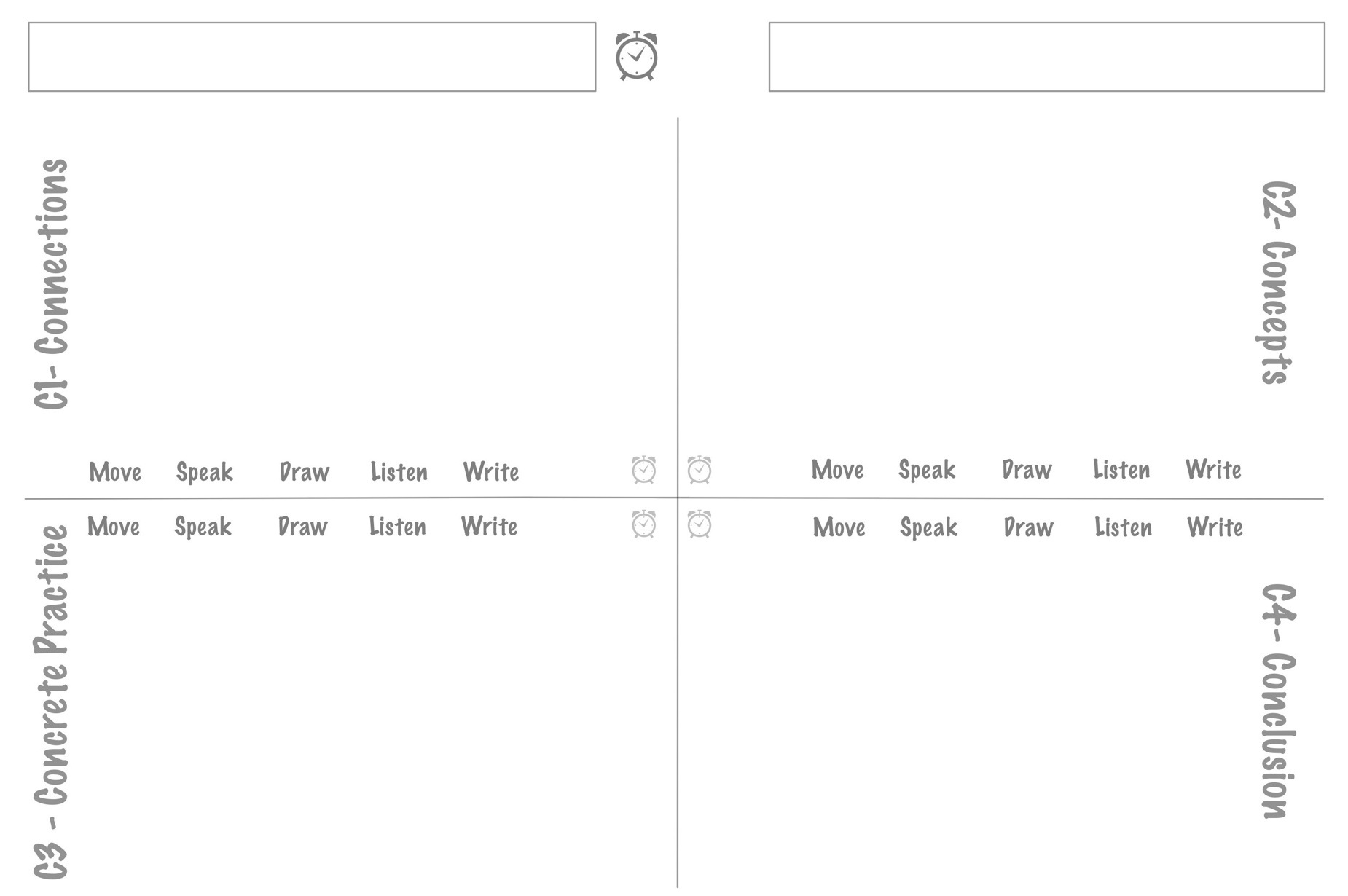
Here is a short overview to help you understand the template.
- The box in the top left corner is for the name of the topic.
- The big clock icon gives the time for the entire plan; the smaller clock icons in each quadrant gives the time needed for that section.
- The box in the top right corner has a space for you to enter the time for a section. For example 9:00 to 9:30 am. This helps you stay on track during the training. These are not filled in on the training plans we provide. We suggest you fill them in when you have planned your training.
- The rest of the page has a quadrant for each of the 4Cs. C1 covers connection activities. C2 is for concepts and is quite often a short lecture. C3 is for concrete practices or some activity to help people understand what they have learned. C4 contains conclusions of how people might apply the learning.
- At the bottom of each quadrant you can circle what the participants are doing in each section: Move, Speak, Draw, Listen, Write. This helps ensure that you have sufficient variety in each topic.
Chapter Layout
Each chapter contains the following:
- overview of the topic covered in the 4Cs plan
- 4Cs training plan
- notes on delivering each 4Cs part
- slides used for the topic
- exercises used for the topic.
Once you have a feel for what each topic covers you can structure your own workshops using one or more topics depending on your goal and time available.
Coach Toolkit
Each book in the series includes a Coach Toolkit which contains the following items.
Training plans: PDF combining all the 4Cs training plans. You should print these out and use them when you train. You will notice that these plans are handwritten, we find them much easier to create and change by hand than if they are typed.
Slides: PPTX containing all the slides used. These slides were created using scanned hand drawings. Some slides have been edited to allow you to insert your own details. For these slides we used Lauren C. Brown font as it closely matches the handwriting on the other slides. If you prefer not to use slides you can recreate these images on flipcharts.
4C template: Use this blank template to create your own 4Cs plans on new topics.
Agreement Cards: PDF of cards used in the Getting Started chapter of each book. We printed and laminated them and use them in nearly every workshop we run. You don’t need to use all the cards each time. Look through the cards before each workshop and decide which agreements are appropriate. The cards help make sure you don’t forget anything important.
Workbook: DOC containing all the pages of a participant workbook. You should print one per participant for them to fill in. Feel free to edit the order and cover page of the workbook. Many of the workbook images were created in Omnigraffle and pasted as images into the workbook.
Other materials: PDFs containing materials to be printed and used in various chapters. Each chapter will reference these if they are needed. These are different in each book.
Room layout
We have trained in a variety of venues around the world, including a computer training centre, a bar and a tent! Room layout can have a significant impact on your training.
Our preferred room layout is cabaret style. i.e. small round tables seating groups of five to seven comfortably. The room should be large enough to have open space for some of the discussions. We look for a room with dimensions 7m x 9m for 20 people, with four tables. Ideally the tables should be small enough (around 1.5m–2m diameter) that people can easily talk to everyone at the table, but still have place for everyone to take notes.
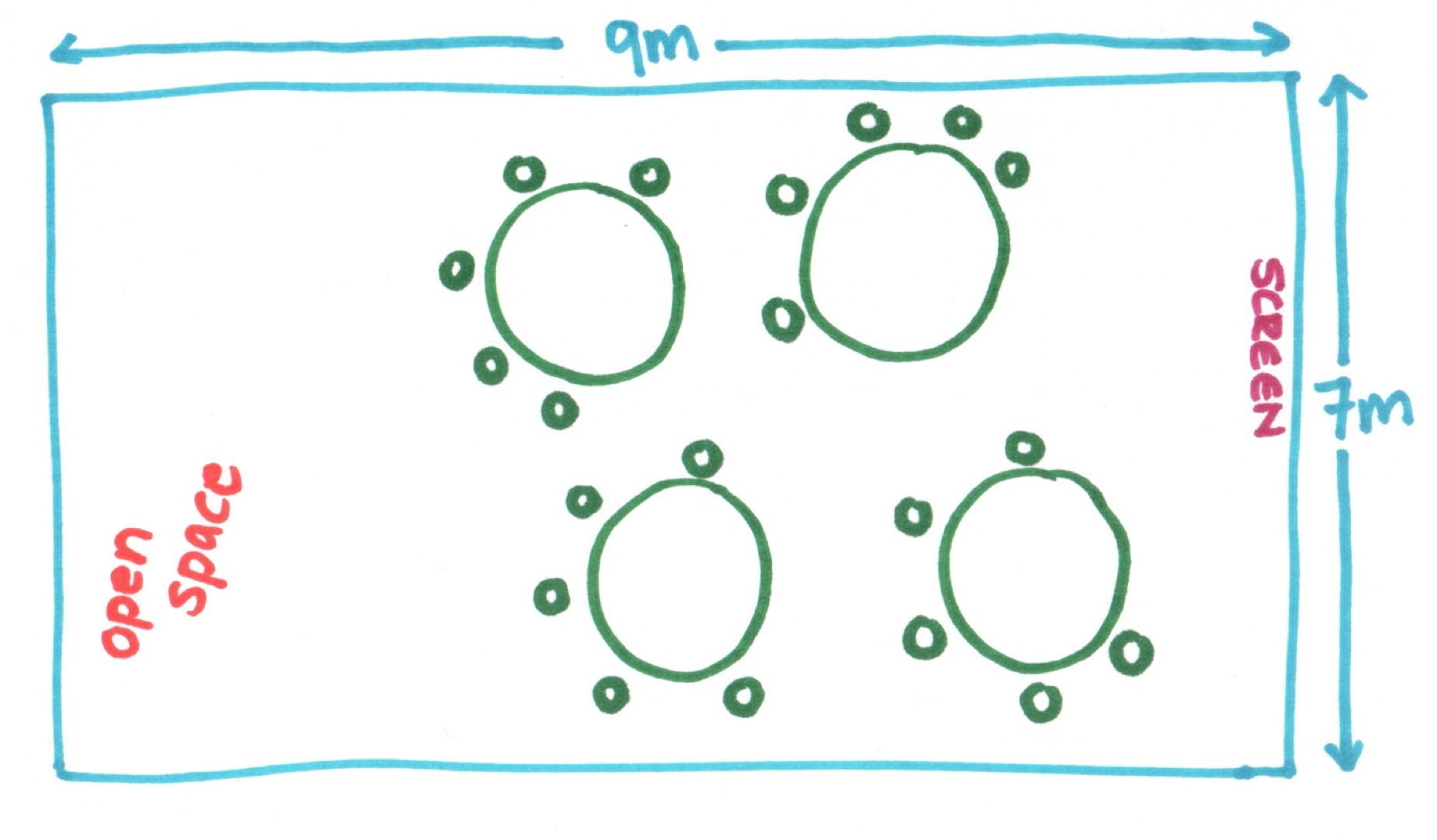
Don’t worry about allocating seats when people arrive. The Getting Started chapter includes an activity for the participants to self-organise into appropriate groups.
If you are facilitating an in house workshop with only six participants, try find a room with a small round table so that everyone can sit close to each other.
When to change exercises
Feel free to change the training plans and activities to suit the class size and time available. We have delivered most of the chapters to groups varying from five to 50 people. As a result we have developed activities that scale well, but it is a good idea to be aware of the size of the group when planning your activities.
All 4Cs plans give times for each activity. These are just guidelines; any activity can be adjusted based on time available. It is often useful to have two exercises on hand, a longer and a shorter one, so that you can adjust if you find yourself with more or less time available.
If you are working with large groups, be aware that debriefing exercises can take much longer. To save time you can have teams debrief in their table group and then ask one or two table groups for their insights. Also remember that some exercises speak for themselves and don’t have to be debriefed - this is the beauty of TFTBOTR.
What else do you need?
We are able to run most of the workshops in this series with our standard training kit. We keep this packed in a small suitcase on wheels so we can take it wherever we go. Below is a list of what you’ll find in our kit. Some books in this series require specific items, these are listed in the Introduction for each book. Each chapter also contains a full list of materials you need for that topic’s training plan, in case you plan to deliver just one topic.
All the techniques referenced in the training plans are available in the Appendix. If you aren’t sure what to do for a Standing Survey or Fast Pass, check the Appendix.
After the workshop or course
Whenever we train or run workshops we take photos. These include action shots during any activities and discussions as well as any flipcharts we use and posters people create.
After the workshop or course we put these photos together in a PDF, and send this to all participants as a reminder of the workshop or course. This photobook is useful if you don’t use slides and participants want some materials to reference afterwards. We also send links to further reading on any topics that came up in the Q&A that were not fully answered.
Chapter 1: Introduction
If a team believes they are agile, but nothing has changed about the way they test, then there is still much to learn. We teach 5 key principles that explain why agile testing is fundamentally different to traditional testing.
This books includes a collection of workshops to help teams grasp these principles and adopt an agile testing mindset. It’s not just for testers. A key part of agile testing is that the whole team is involved, so we always run these workshops with everyone in the team.
If your team is ready for the next level we highly recommend running through the workshops in this book, it will teach them a number of simple but valuable techniques to help prevent bugs and dramatically increase the quality of your products. We provide the facilitation plans, teaching points, and even the slides you might use to help you run the workshop.
The chapters in this book each relate to a different topic on agile testing. You can use the book in a number of ways.
- You could use all the chapters together to deliver a half or full day training course on Agile Testing. This is usually how we run the workshops, and so many chapters build on things done in the previous chapter.
- You can use an individual chapter to run a workshop session on a particular topic of interest. We recommend doing the Agile Mindset first as it is reinforced in the rest of the chapters.
For each chapter, you can expand the learning by using the technique just taught on items the team are currently working with.
Unlike our previous book on Training Scrum, we don’t assume you are an expert on the topics in this book. Not every coach and trainer have come across the same tools. If a topic is new to you, we have provided details of the points we teach for each topic in the C2 section.
You only need the standard training kit mentioned in How to use this Series to run most of the workshops in this book. However, if you plan to run the Jenga game mentioned in the Getting Started chapter, you will also need a few Jenga sets. Two sets are enough for up to 18 people.
Since testing and requirements are closely linked together we recommend our Agile Requirements book (part of the series) as a good companion to this one.
Chapter 2: Getting Started
We spend time at the start of a workshop session building connections and getting people to bond with each other and us. This immediately increases the level of trust in the room. If you are running a 90 minute workshop with people who all work together, you don’t need to spend as much time on this. In that case we might only do the Jenga Game in C4. If you are doing a full day session with people who don’t know each other well, we’d recommend following the full plan below.
4Cs Training plan
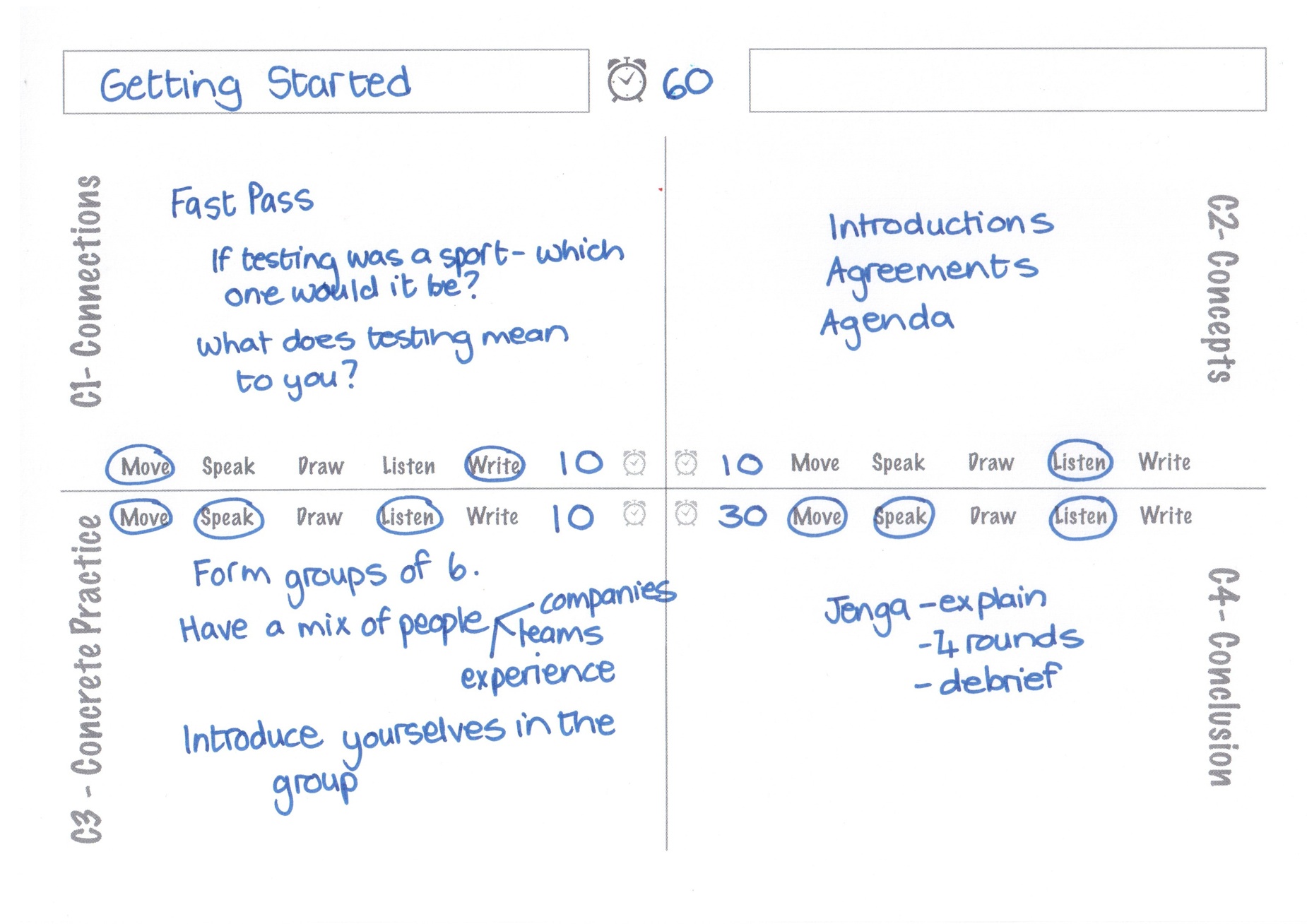
FastPass (C1)
We start with Fast Pass posters. Ask everyone to form pairs and together write up one sticky note for each of the posters. The posters we chose for this workshop is “If testing was a sport - what would it be?” and “What does testing mean to you?”. This allows for participants to instantly identify with the topic and for us to get a better understanding of their mindset around testing.
The posters are usually flipchart sheets with a question written on them in bright colours. You can see an example of these posters on the slide below.
Slide
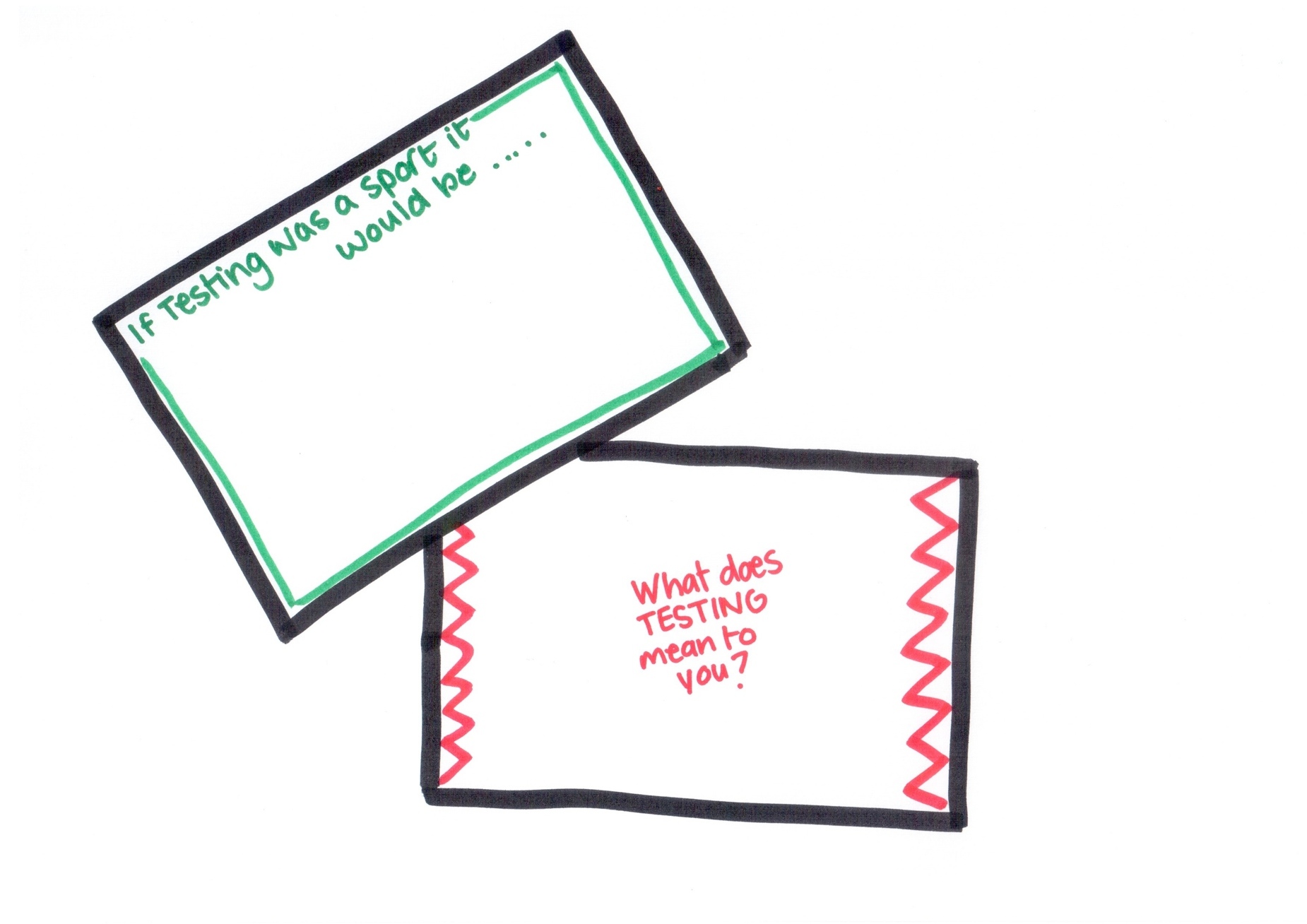
Introductions (C2)
Simply introduce yourself by saying who you are and what your experience is. Don’t bore people - keep it short and entertaining. Our names, Twitter handles and company website are shown on a slide (see below). If you are doing this training in house with people you know, this slide might not be needed. Perhaps instead share something people might not know about you. You probably also want to mention the goal of the workshop, and why you are there.
Slide
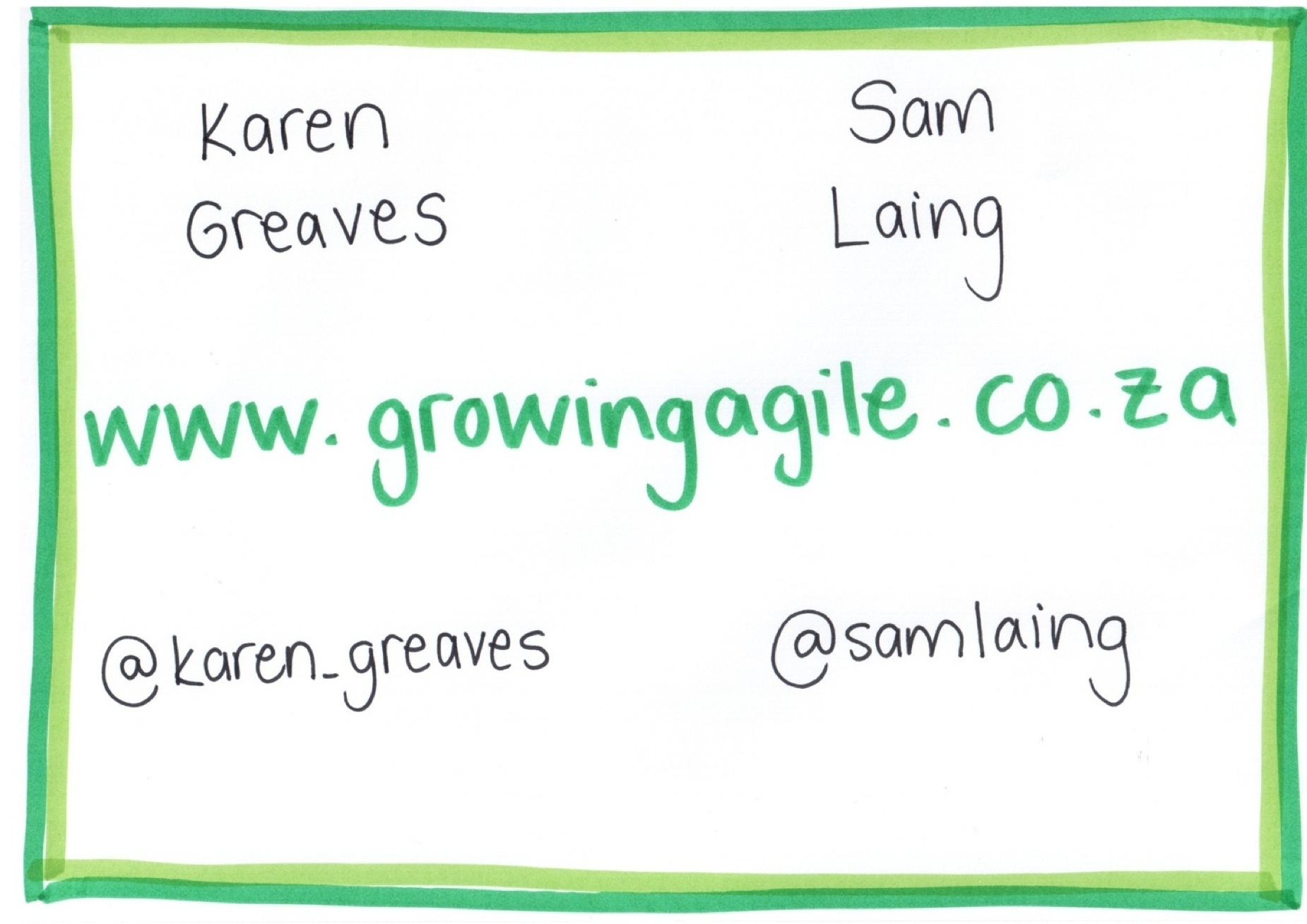
Agreements
Next go through some Agreements (like rules, but we don’t like that word - too formal). For example: “Please put cellphones on silent, but feel free to leave the room if you need to take a call”. This helps to set the tone for the workshop. It also allows everyone to understand the boundaries of behaviour that are expected for the duration of the workshop. The Agreement cards in the Coach Toolkit will help you remember things to mentioned. Pick the cards most appropriate for the workshop and run through each of them quickly.
Agenda
Briefly go through the agenda for the day. Most people want to know at a high level what will be covered, and most importantly when the breaks and lunch are, and what time they will finish. We put this information up on a slide, and explain that the times are approximate, although we should be within 10 minutes of them at all times.
Form groups (C3)
Ask the class to form groups of five to six people with a mix of people in each group. Encourage them to rather mix up companies or teams if possible. Once people have formed groups ask them to introduce themselves to everyone in their group.
Jenga Game (C4)
In order to illustrate some testing mindset shifts we play a little game. This is a fun and light hearted way to get people thinking differently about testing and what is possible. Introduce the Jenga game and then play it with the class.
Chapter 3: Agile Testing Mindset
Before teaching any techniques or theory we like to help people understand that agile testing is fundamentally a different mindset to traditional testing. This topic presents five key differences in the form of a testing manifesto, which was inspired by the agile manifesto. We often deliver this topic as a stand alone workshop, with the Jenga game at the start or even public talk. It’s a great introduction to the concepts in agile testing. Often the phrases we refer to in this topic like “Testing is an activity not a phase” are the things teams remember most and repeat to each other after we have trained them. Proof that presenting this topic this way help it stick in their minds.
4Cs Training plan
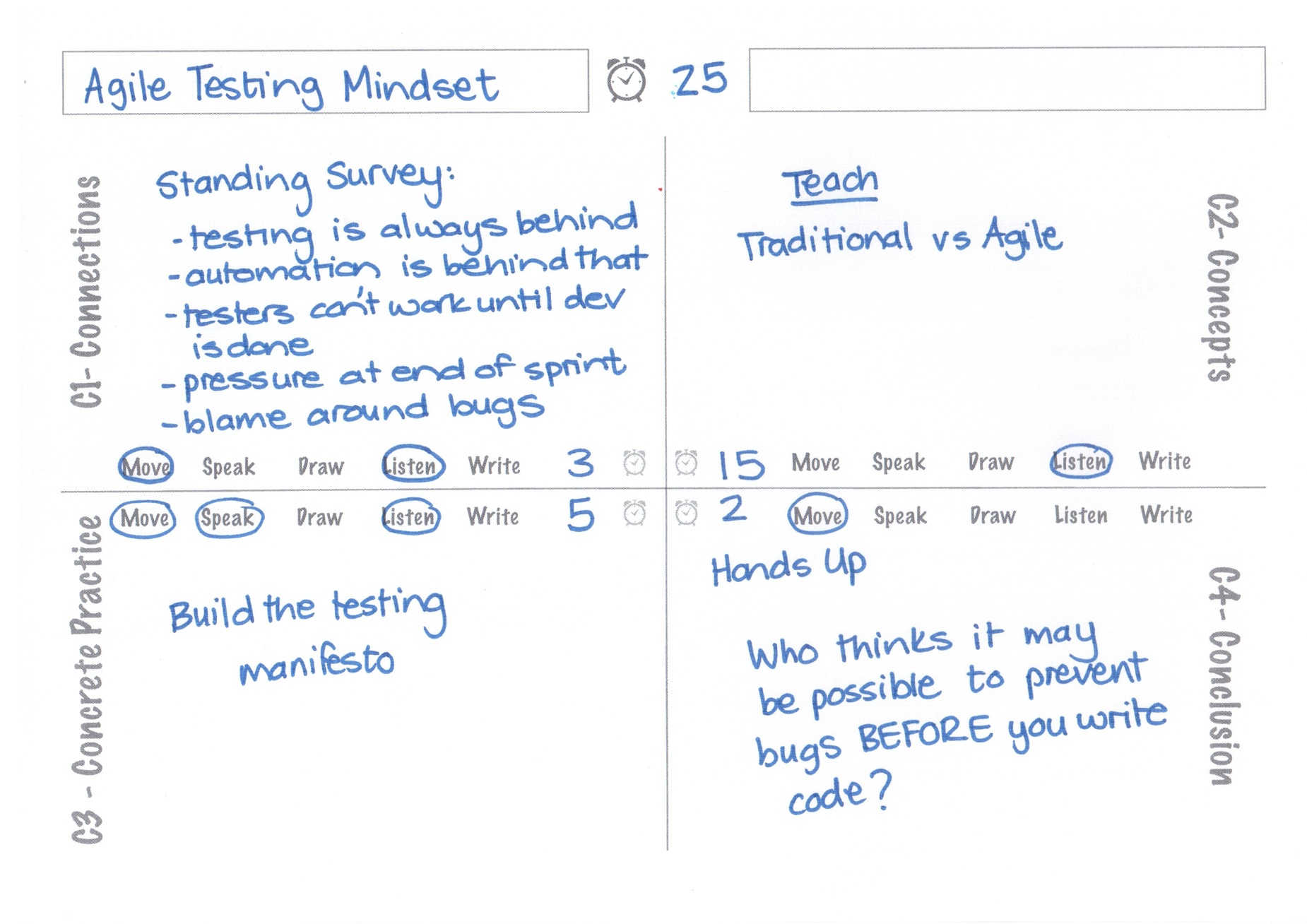
Standing Survey (C1)
This helps everyone in the room get to know a little bit about the testing problems others have. Ask people to stand if any of these are true for them:
- testing is always behind
- automation is even further behind that
- testers can’t work until development is done
- there is pressure at the end of a sprint
- there is blame around bugs (its his fault etc.)
Teach (C2)
Introduce the idea that agile testing is not just testing the same way you always have, except in sprints. Explain that the entire way the team thinks about testing should change. Then present the five mindset points below. Each is presented as the traditional way of thinking about testing and then the agile way of thinking. Contrasting like this can help people understand the differences, but it also helps them reflect which side they are closer to at the moment.
Testing is an activity not a phase
Traditionally people view testing as a phase that happens at the end of development. In agile most have changed it that the chunk of development done is smaller, but the testing still happens last. Nothing has fundamentally changed about how testing is done.
One way to see if this is the case is to ask people about their taskboards. If taskboards have a separate column for testing, it’s a sure sign that testing is still being thought of as a phase.
In contrast in agile, testing is just an activity that needs to happen, along with coding, documentation and everything else. Thinking about it like this makes it possible to consider the idea of doing testing tasks before development work. A great way to visualise this on a taskboard is that instead of having a separate column for test, rather just make testing tasks a different colour sticky note. Now put all the tasks in the “To do” column together. Challenge the team to see how many of the testing tasks they can do before any development tasks happen.
For example you can create test cases before any code is written. That way you know how you are going to test it before you build it. You could even create automated acceptance tests first. These should fail since there is no code yet, but once the code is written and the tests pass, the work is done, and there are no test tasks left. Working this way will remove the hurdle of testing always being behind. For some people this is a huge step, however just breaking the mentality that testing tasks follow development is a great start.
Another useful technique is the “Show Me” column. Put it after the “In Progress” column, before the “Done” column. Most teams do code reviews, documentation reviews or even test case reviews on each story. The idea behind the “Show Me” column is to do a review on every task as soon as that task is done. If tasks are small these are micro reviews that might only take a few minutes, but they ensure that at least two people in the team have seen every piece of work, and this can help catch and fix issues much earlier.
Slides
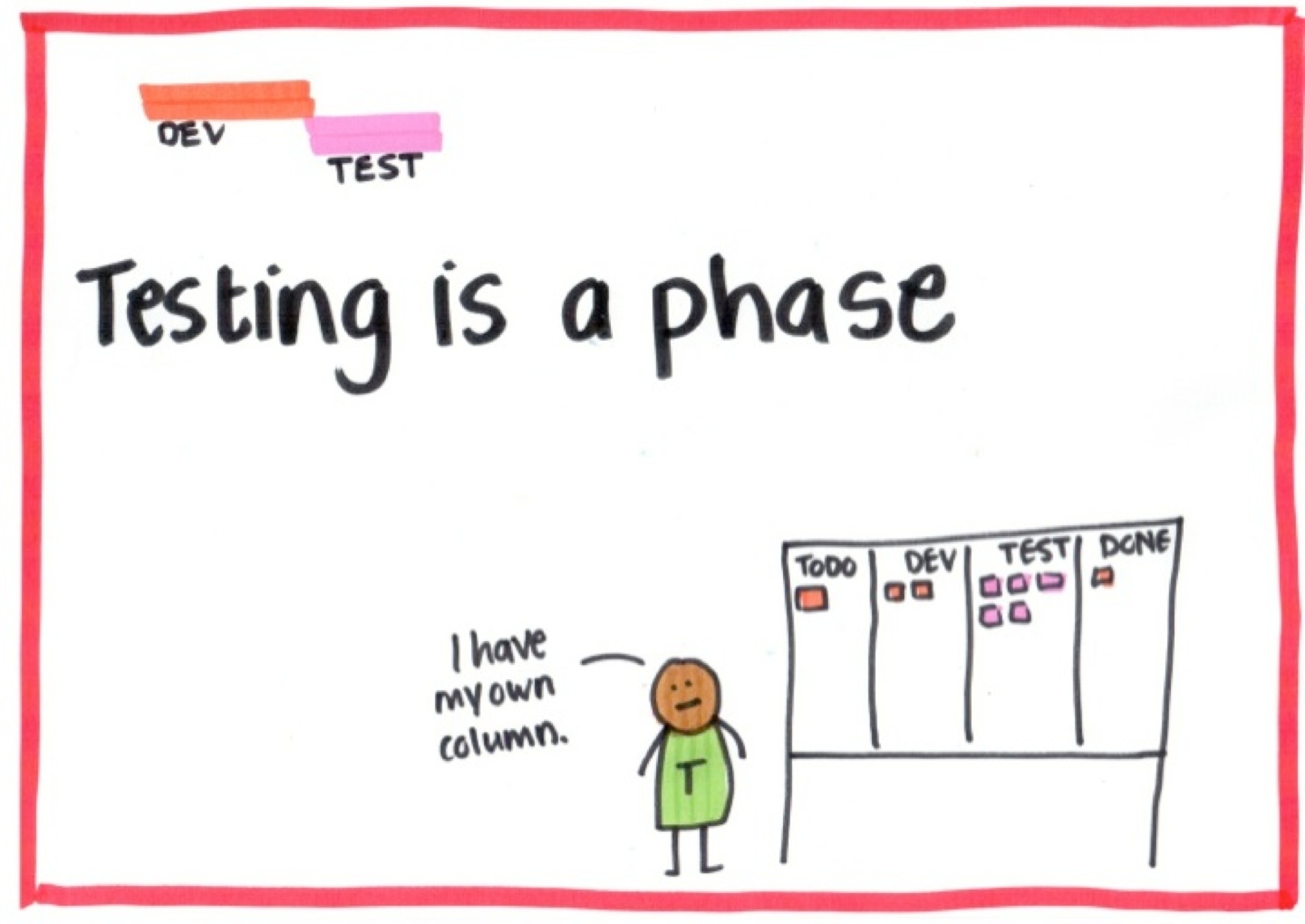
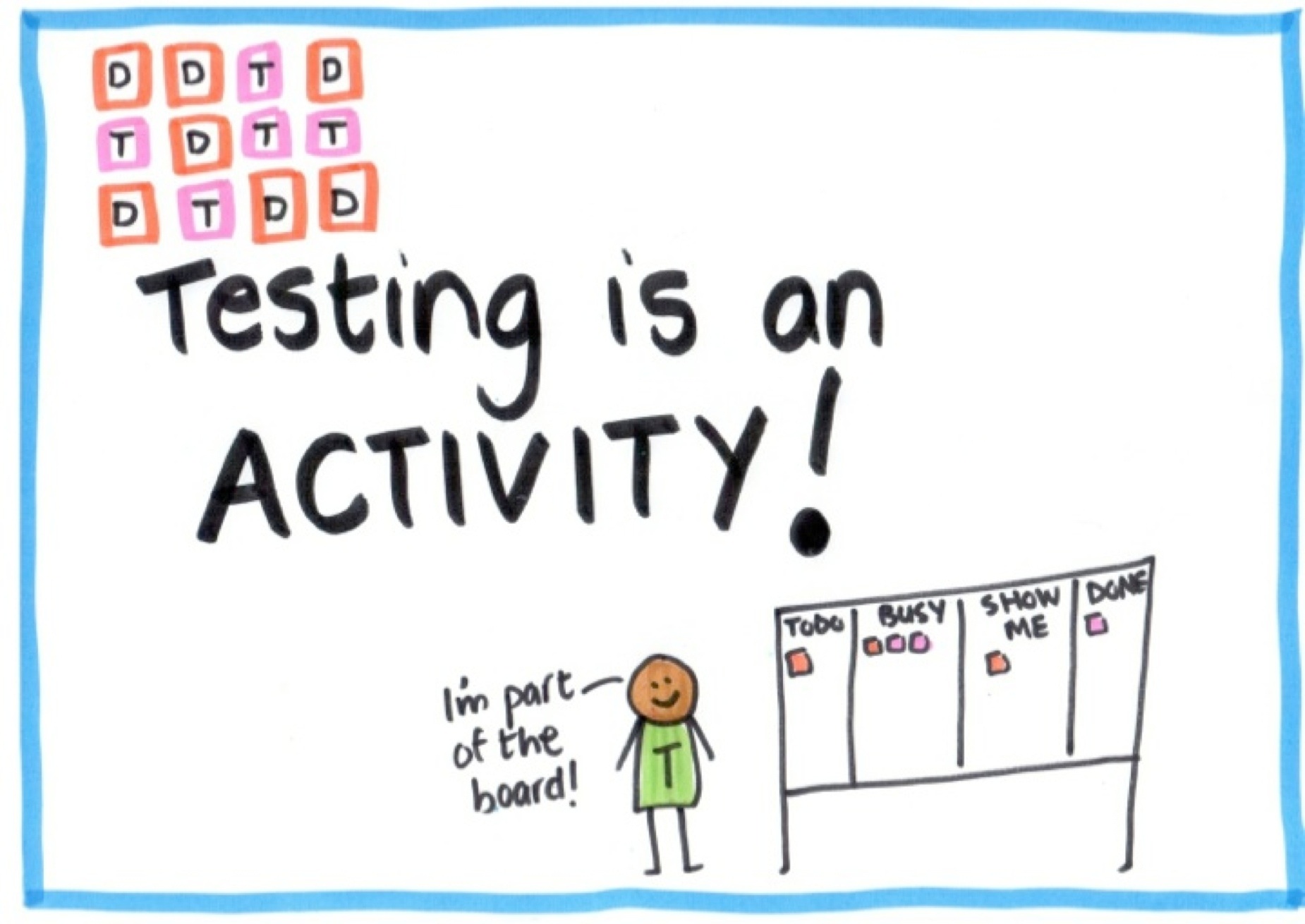
Prevent bugs rather than finding bugs
Traditionally people think that the goal of testing is to find bugs. In fact some organisations even measure tester productivity based on the number of bugs they find (or don’t find). Once again this mindset is limiting, and helps reinforce the idea that testing is something that happens at the end.
Use the star example to illustrate this point. Show the star slide or draw the star on a flipchart and ask people “How many points are there on this star?” People might offer a few numbers: 5, 10, 20. Ask people to write down the number of points they think it has. The ask people to raise their hands if they wrote anything other than 5.
Now show the next slide, and explain that the point inside the circle with a tick is a point (and only one point), and that the other circle with a cross is not considered a point. Hopefully now everyone can agree that there are only 5 points on a circle.
Explain that anyone who wrote down a number other than 5 created a bug. Ask if they could think of any way that they could have prevented that bug. Hopefully someone will realise that they could have asked you what you mean by a point before writing down their answer. If no one mentions this, you can. Explain that this works exactly the same way in software. Often people make assumptions about requirements and implement those assumptions before clarifying them. The assumptions are only clarified once the software is tested, and the bug is then found. Imagine how much more productive it would be to have a short conversation to clarify assumptions before anyone wrote a single line of code.
This example introduces the second agile mindset principle. Agile testing aims to prevent bugs by seeking to eliminate all assumptions and unknowns before starting to code. The goal is to make sure everyone from the customer to the developer and the tester have exactly the same understanding of how something should work. The best way to prevent bugs is to ask questions, especially stupid questions. Ask questions that everyone thinks the answer to is obvious. Remind them of the star. To some people it was obvious that their were 20 points.
Our favourite example for this was a team that needed to create a report showing the average sales data for the last six months. Everyone thought they understood the requirement perfectly, and it didn’t need much discussion. We happened to be there and we asked some questions:
- If I run the report on 1 February is data from February included or not?
- What about if I run the report on 29 February?
- How exactly should the average calculated, as monthly average, or the average over the six months?
- Does the average need to be stored or is it calculated on the fly?
- Does the report need to be stored, or will it only be created when someone selects it?
- What field in the database is the average calculated from?
- Who would be using the report and why did they need it?
It soon became very clear that no one had considered these items, and that more information was needed before they could build the report. Imagine the rework and bugs that could be created if you built this without the answers to these questions.
Slides



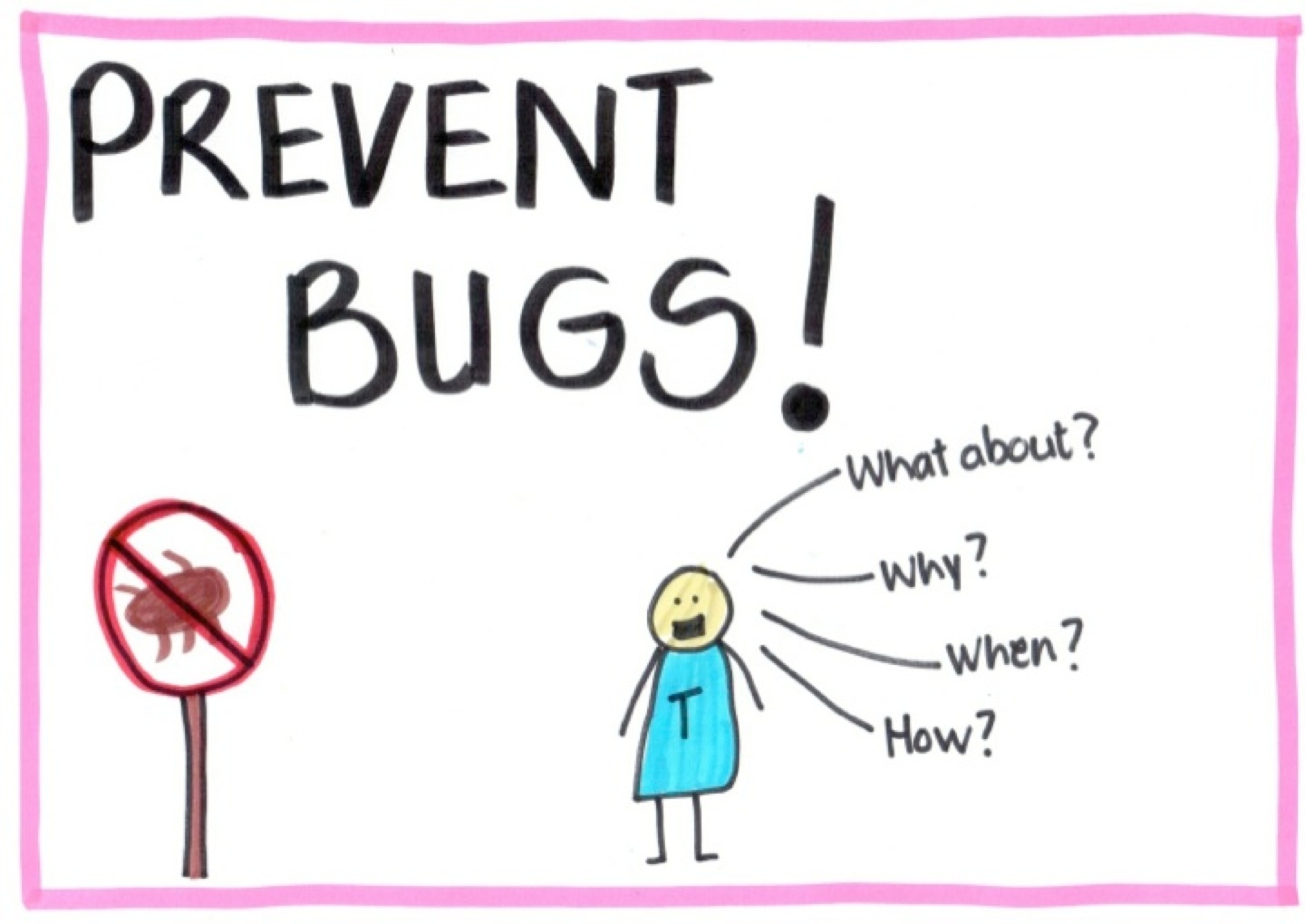
Don’t be a checker, be a tester
Traditional testers often don’t like agile because without detailed specification documents they are suddenly unable to do their jobs. This is because they consider their job being to compare the working system to the specification, and report where there are discrepancies. If you think about this for a second, the only thing they are checking is how closely the developers followed the specification. This actually says nothing about the quality of a product, or more importantly if it is fit for purpose.
We call this work ‘checking’. You know what’s really good at checking? Computers! Checking that 1 + 1 = 2 is easy work for computers to do, and they will get it right every single time. They don’t get bored or tired or distracted. With agile testing simple checking should be automated so that testers can be freed up to do the kind of work computers can’t do. Things like exploratory testing or usability testing.
In agile, testers need to become customer advocates. They need to deeply understand who their users are and what they are trying to achieve with the product. They should be the representative of that customer in every design decision, ensuring that the feature meets the customers actual needs, not just the specification, or even what they asked for.
When a user asks for a feature, ask them: “How would you test that?” or “How will you know if that works?”. This can help understand the real result the customer is looking for. Translating that into acceptance criteria for the team can ensure the product does the right thing.
Slides
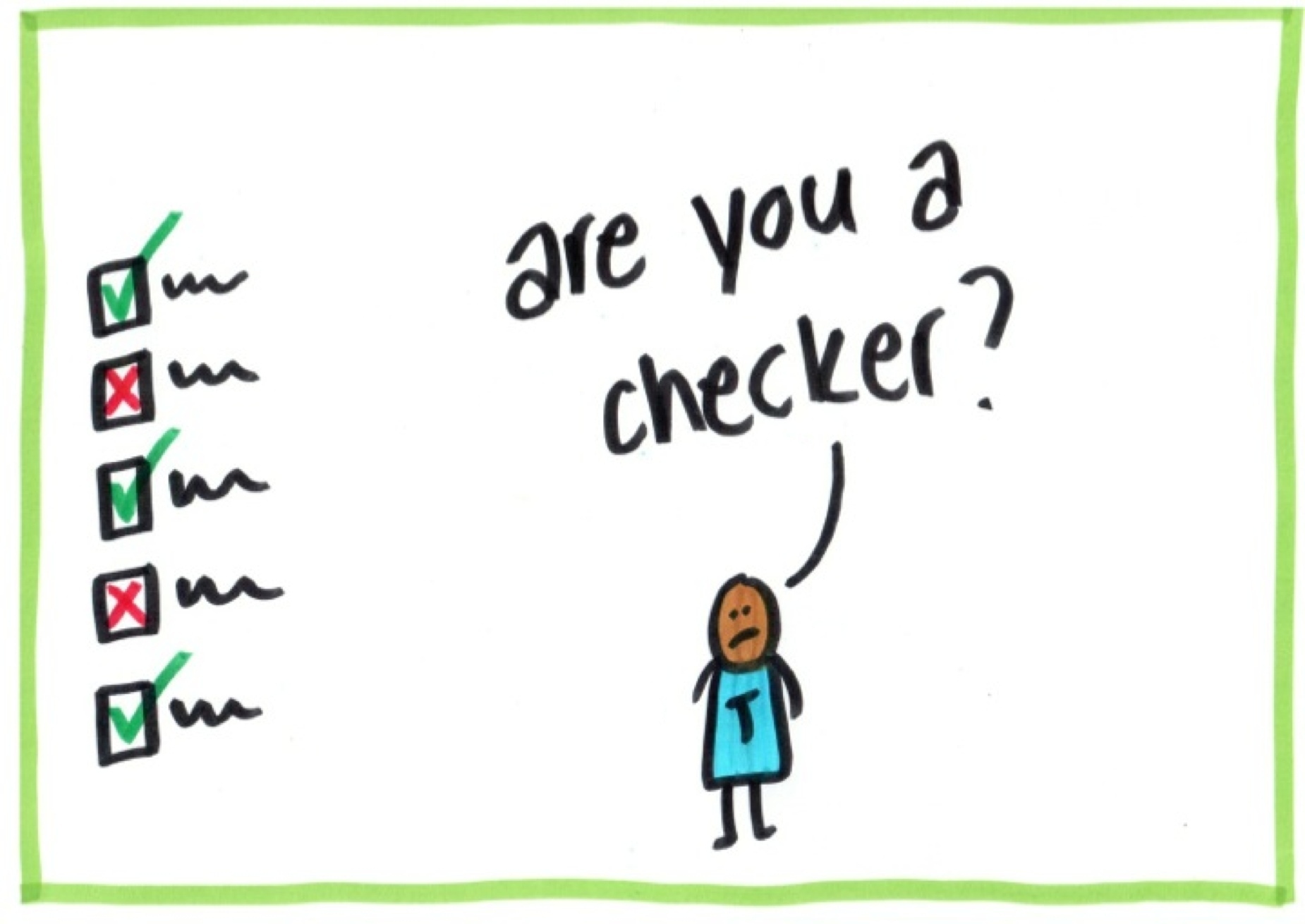
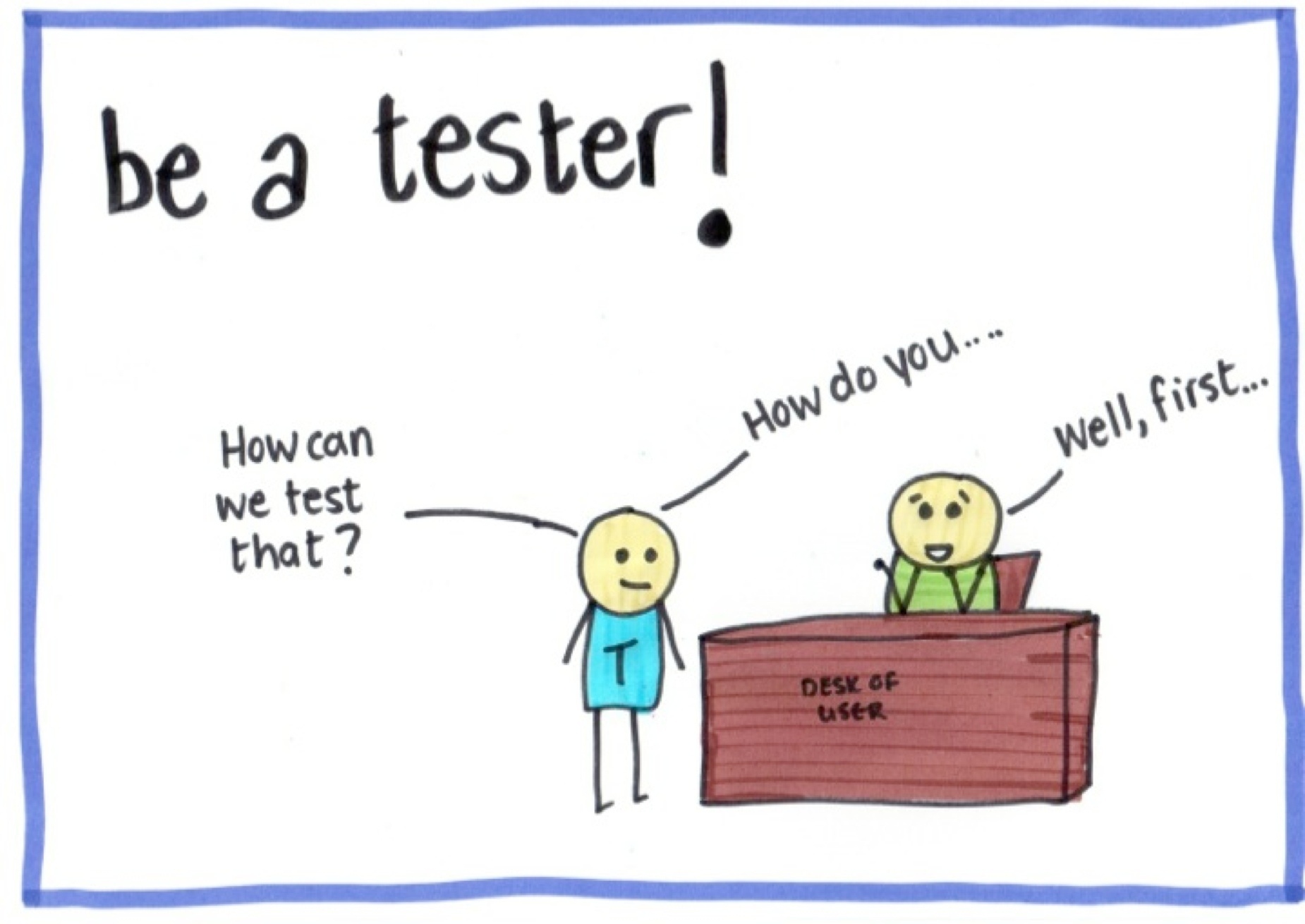
Don’t try to break the system, instead help build the best possible system
Testers like to break stuff. Yes that’s a generalisation, but it is certainly true for the majority of testers we meet. The problem with this mindset is that it creates a divide between the developers and testers. Developers build it, then testers try to break it. See how this reinforces the other traditional mindsets like testing as a phase. When this gets really extreme some strange stuff happens, like testers telling developers how they will test the product. We like to share the following story.
Many years ago I (Karen) was working as a project manager on a traditional waterfall project. We were nearing the end of development and preparing for the final test run before user acceptance testing (UAT). I was discussing the upcoming UAT with the client, and here is what they said to me. “We don’t want to share our UAT test cases with you, because then you might just build the system to make those test cases pass”. At the time I agreed and said I understood. Now I literally laugh out loud at the absurdity of this statement. Surely the client wanted software that would make their UAT test cases pass. Wasn’t that in fact our joint goal!
The agile mindset is that testers should be helping to build the best system possible. They shouldn’t be celebrating when they find a bug, they should be celebrating with their whole team, when the product works, and solves a business problem in a simple way. The best way to do this is to figure out how to test the system from a user point of view and then share that with developers before they start coding. Chances are high if you do this, they might actually build a system to make those tests pass.
Slides
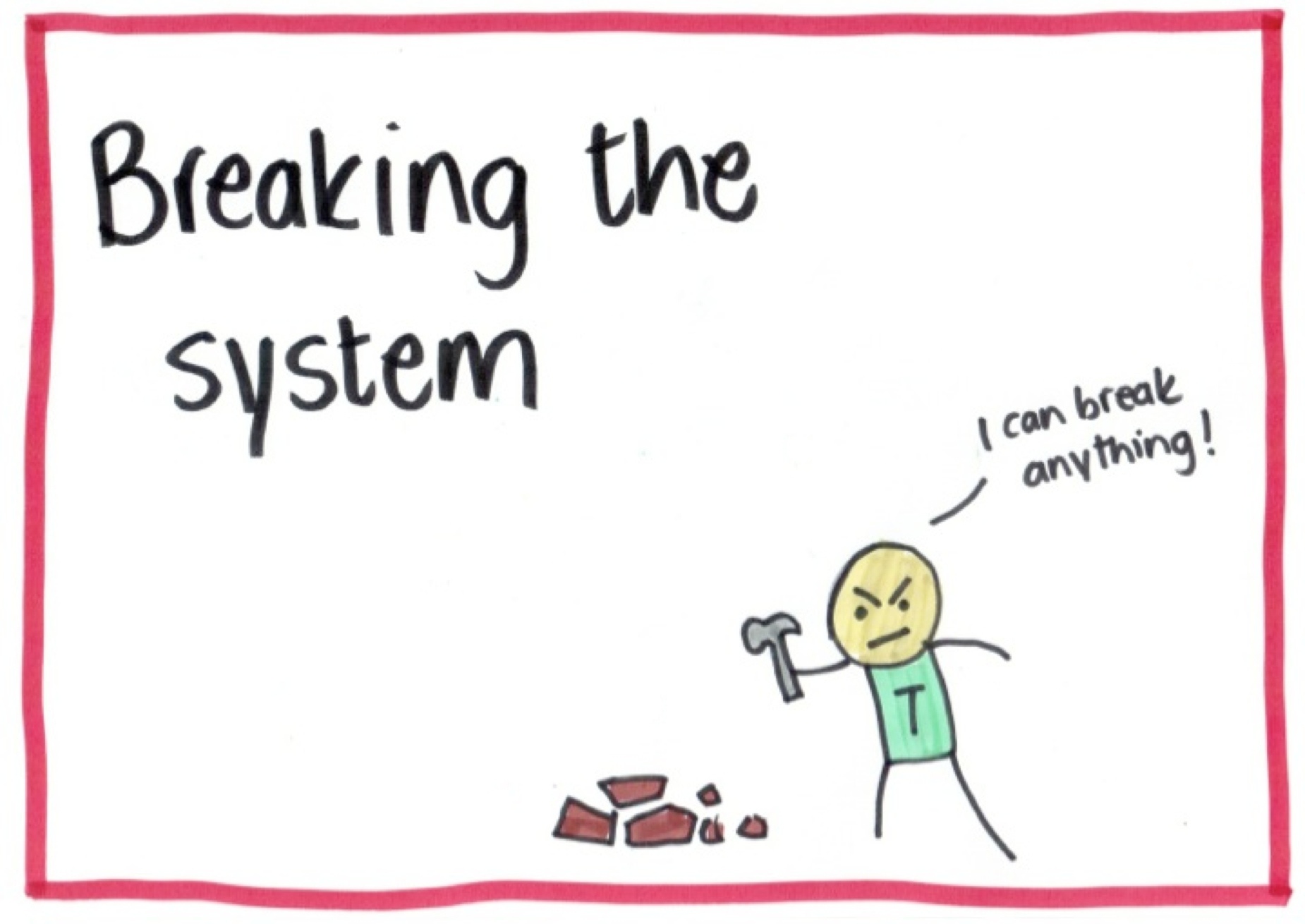
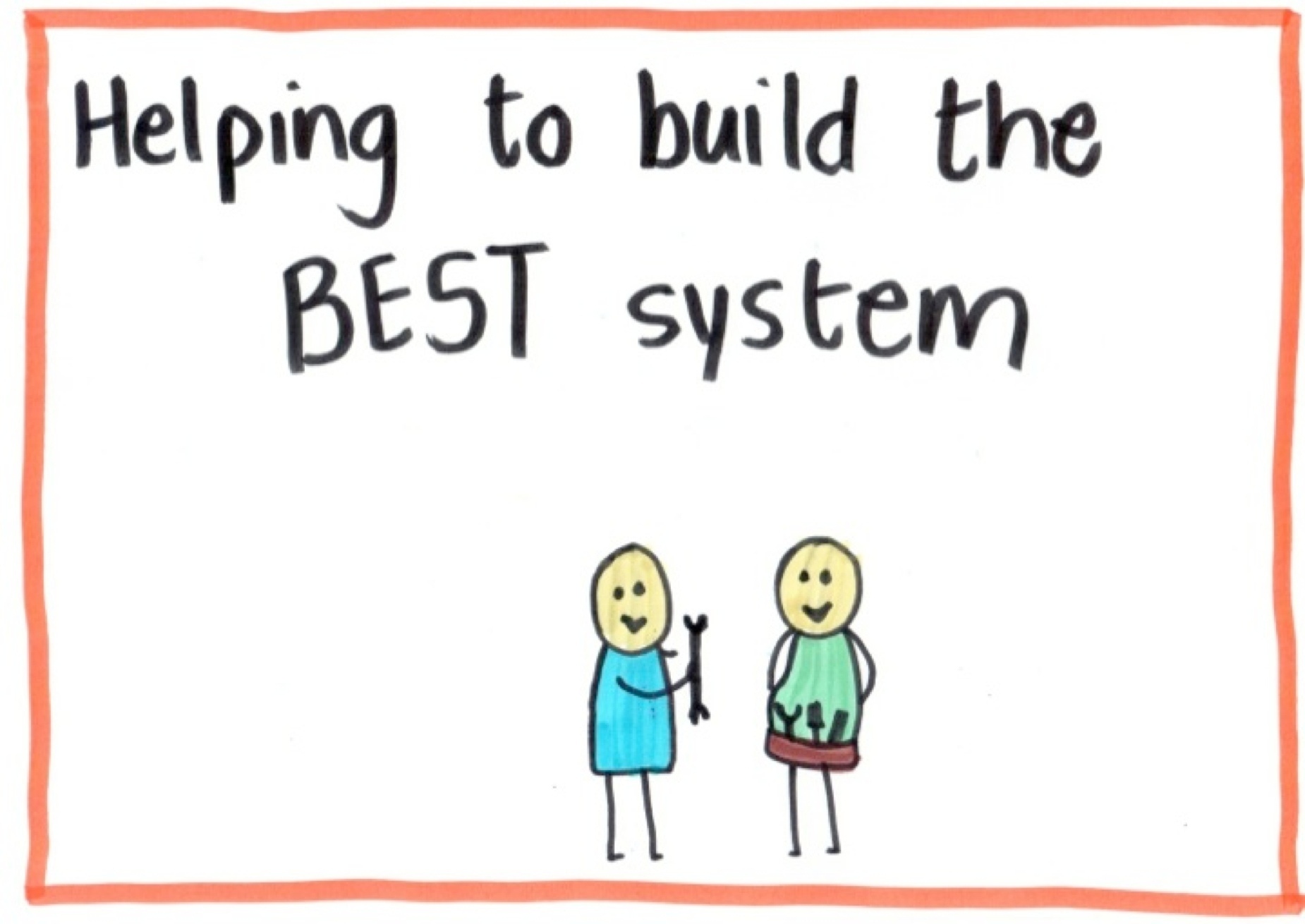
The whole team is responsible for quality, not just the tester
Traditionally it is the tester, or the test team that is responsible for quality. They get the final say in whether a product is ready to be released or not. The problem with this mindset is that it implies then that only the tester cares about quality and only the tester spends their time ensuring it happens.
Instead in agile the whole team is responsible for quality. This helps teams realise that testing is an activity they all need to take part in and that it happens throughout the work. If customers find a bug in production, no one should be asking the tester why they missed that. Instead the whole team should be discussing together how they can prevent that from happening again in the future.
Once this mindset is adopted, testers are no longer the only people busy at the end of the release, the whole team is involved.
Slides
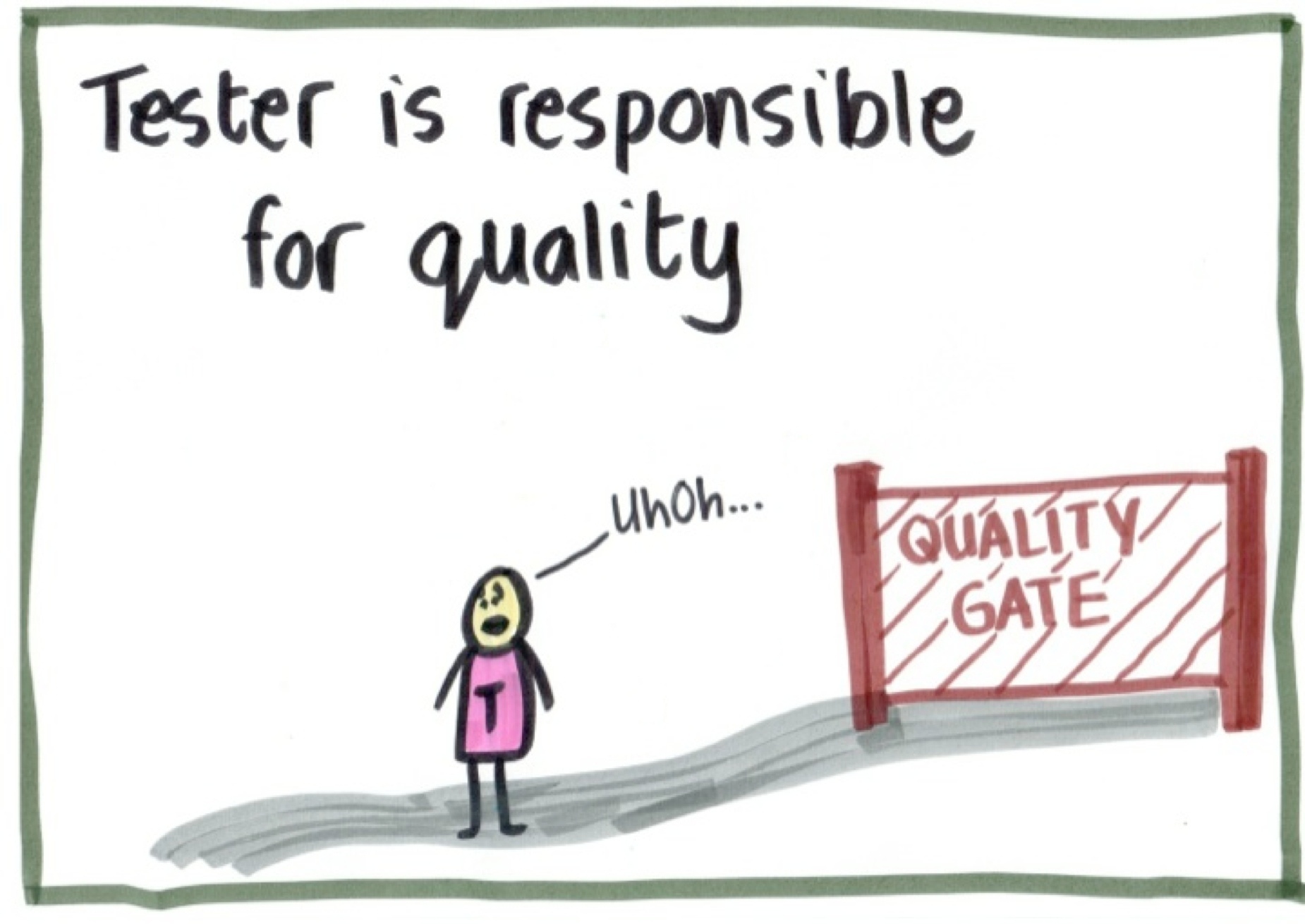
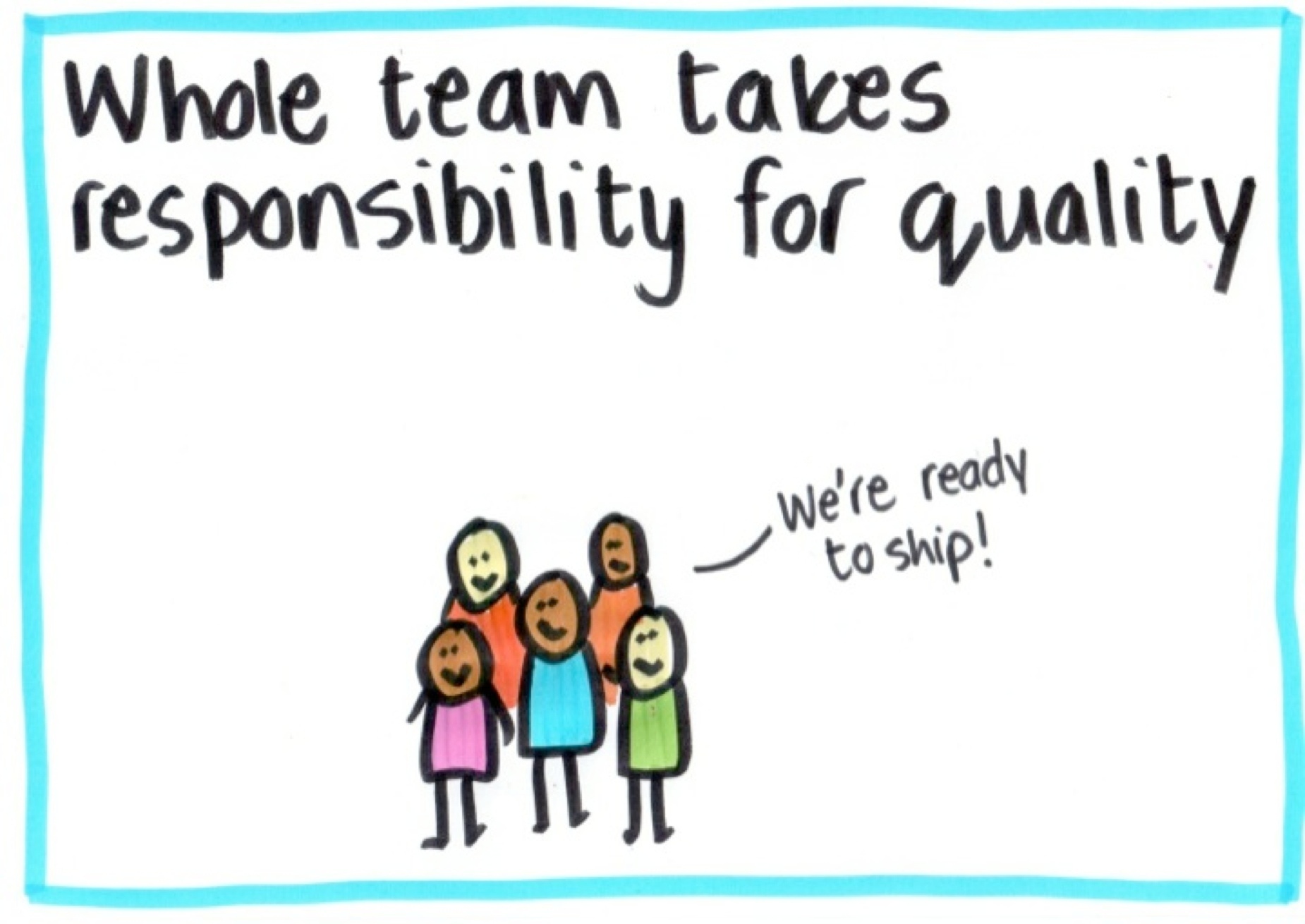
Testing Manifesto (C3)
Hand out a pack of Testing Manifesto cards to each group. Ask them to place the cards in this way: we value __ over __ , five times. Walk around and help with reminders if anyone seems stuck. Once all groups are done, show the slide with all five statements and quickly read through it.
Slide
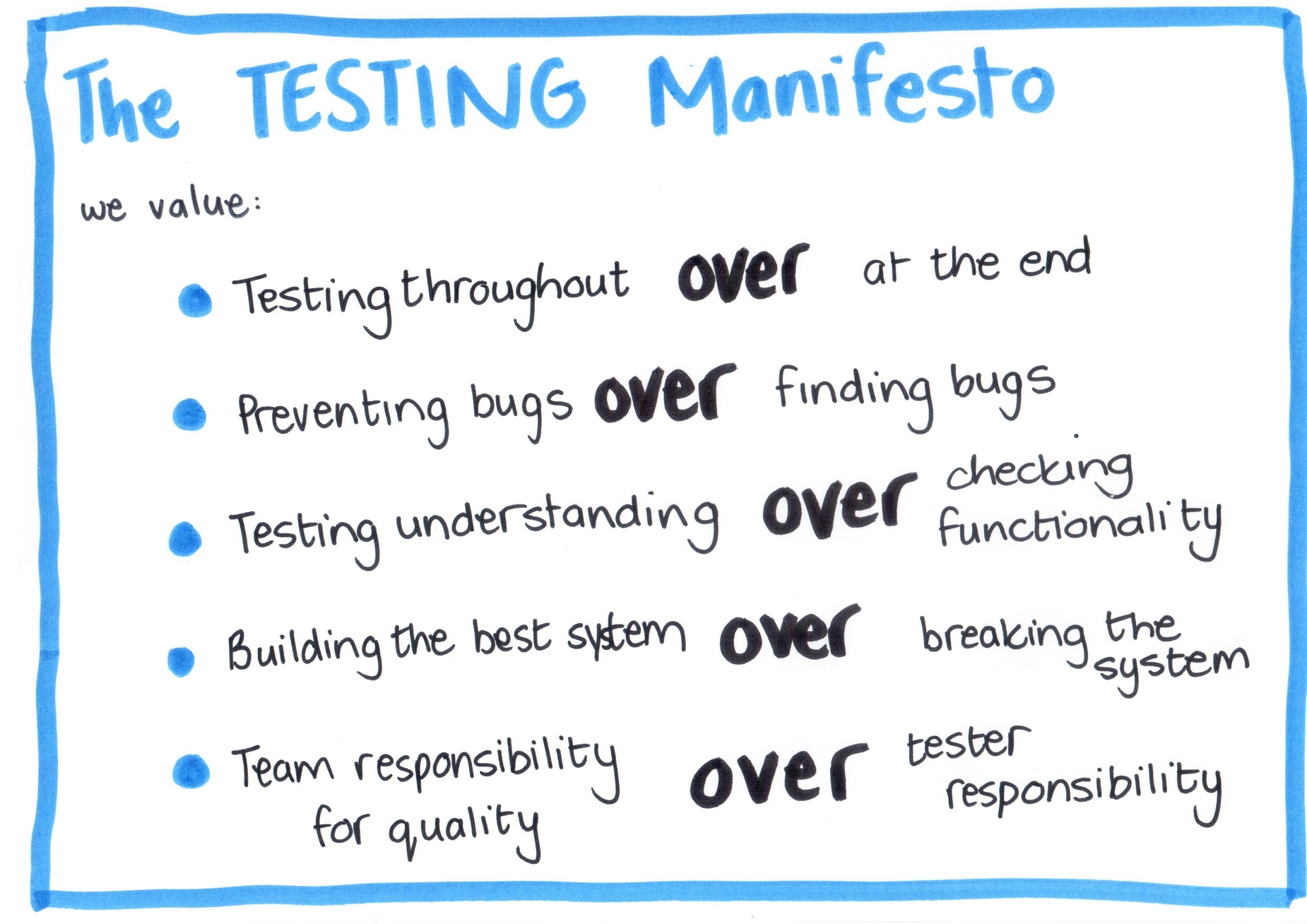
Hands Up (C4)
Ask people to raise their hands if the following statement is true for them.
- Do think it might be possible to prevent bugs BEFORE you write code?
Appendix
Agreements
| 5 | any number | Communication | ||
| minutes | people |
What you can learn
This sets a tone and expectations near the start of a session. It helps the attendees know what the boundaries of the session are, and what behaviours are acceptable.
What you need
It is best to have each agreement on a card and to go through them near the start of the session.
How to do this
Decide which agreements are appropriate for your audience and meeting. Explain them clearly and simply near the start of the session.
You can also ask participants if there are any agreements they would like to add.
How we’ve used this
We change these depending on the session we’re running. Over time you will learn more techniques and so this list will keep evolving.
Here are some of the cards we have:
- Take Care: Take care of your own needs. You don’t need to ask permission to go to the bathroom, or get coffee.
- Cellphones: Keep your phones on silent please. If you need to take a call, just leave the room. We’d rather you were paying attention than worrying because your boss/wife/child is calling.
- Right to Pass: You have the right to pass in any activity or exercise we do. Just sit to the side and observe.
- Workbooks: These are yours to keep. Please take notes. We will let you know when we are doing specific exercises in the books.
- Timeboxing: We give a specific end time for each break. We will start at that time whether you are back or not. It’s up to you to choose to be on time or not.
Who shared this with us
Various people over the years, many from Sharon Bowman. We came up with the concept of using cards to remember all of the things we wanted to say.
Fast Pass
| 10 - 15 | 6 - 20 | Movement | ||
| minutes | people | Trust |
What you can learn
An activity to connect participants to each other through content related to the session. This is a great technique to use at the start of a session, so people who arrive early have something to do.
What you need
Flipchart pages stuck up on a wall, with questions. Have a minimum of three (for six participants) and a maximum of five (for 20 participants).
Some questions might be:
- What are your pets’ names?
- What do you know about Topic of session?
- Why are you here today?
- What is your biggest strength?
- What is your company’s greatest challenge?
Instruction flipchart:”After reading this, introduce yourself to a stranger and fill in the flipchart questions around the room with them.”
Marker for each participant.
How to do this
At the start of a session stick up the prepared flipcharts around the room and place the instruction flipchart near the front of the room.
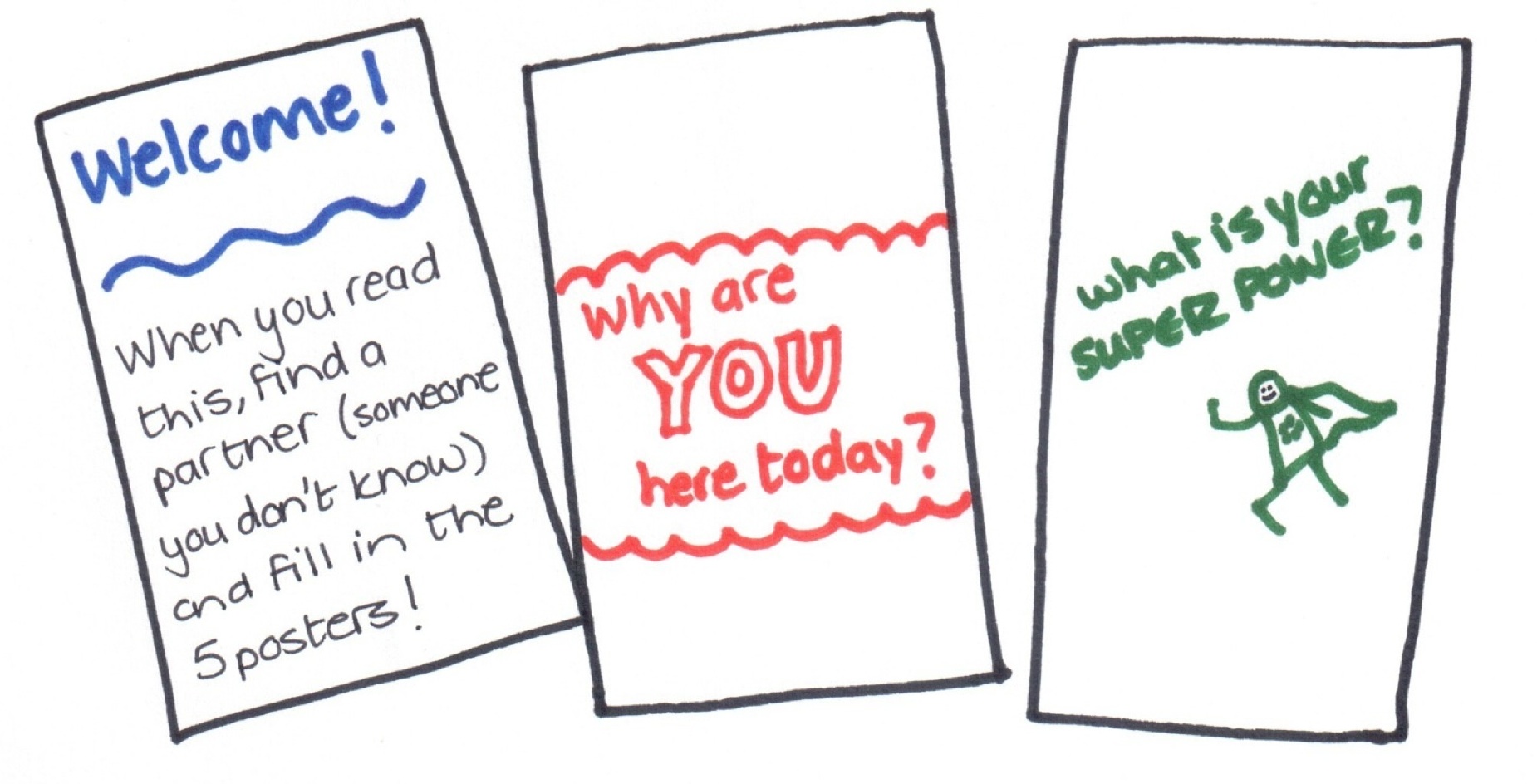
Encourage people to read the instructions if they don’t notice them, and let them know they can start whenever they like.
How we’ve used this
We often use this at the start of training courses, or large group meetings, especially if people don’t know each other. It is a great way to get strangers talking at the start of the day.
Who shared this with us
Jenga
| 30 | 4 - 30 | Testing | ||
| minutes | people | Quality |
What you can learn
This game is a great way to teach people the benefits of testing early and in smaller batches, before development is complete. This simple game demonstrates how it is actually faster to test earlier.
What you need
- 36 Jenga blocks per group of 6, number each block from 1 to 36. Be sure to write the number with a permanent marker on each side of the block (i.e. 6 times per block).
- Handouts with 4 bug numbers for each round. Pick any 4 numbers between 1 and 36 for each round. For example: 2, 17, 21, 36. You need one copy of the numbers for each group.
- A stopwatch or timer
- A flipchart or whiteboard to write up the results
How to do this
Split people into groups of 4 to 6. Try to have the same number of people in each group. Explain that the goal is to build a tower with Jenga blocks. The requirements are that the tower must use all 36 Jenga pieces and must be at least 4 Jenga blocks high, with the blocks stood up on the small end - see the picture below.

The tower does not have to be built like it is in Jenga when the game starts. Some people assume this, if they do, don’t correct them. It leads to a great teaching point since it makes fixing the bugs particularly hard. If people ask tell them they can build the tower however they want as long as it meets the requirements.
Round 1
Before the teams start to build ask each team to nominate two people on their team to be testers. Ask the testers to come forward and brief them separately. Hand the testers from each group the list of ‘bugs’ for the first round. This is just a list of 4 numbers between 1 and 36. Explain that they can’t show the bugs to the builders on their team, but once they have finished building the tower, the testers must find these ‘bugs’ and remove those pieces from the tower. If the tower collapses when they are removed, it needs to be rebuilt. The end result needs to meet the original height requirement, but the tower must be built from only 32 pieces (i.e. the original 36 without the four ‘bug’ blocks).
Once the testers return to their teams, let everyone know they can start and that they should let you know when they are complete. Start a timer at this point, so you can track how long it takes for each team to finish. Make sure testers don’t reveal the bugs until the end. Once people finished, capture the time it took for each group. Only take the time once the tower is complete without the ‘bugs’.
You can write the results on a poster like those shown below.
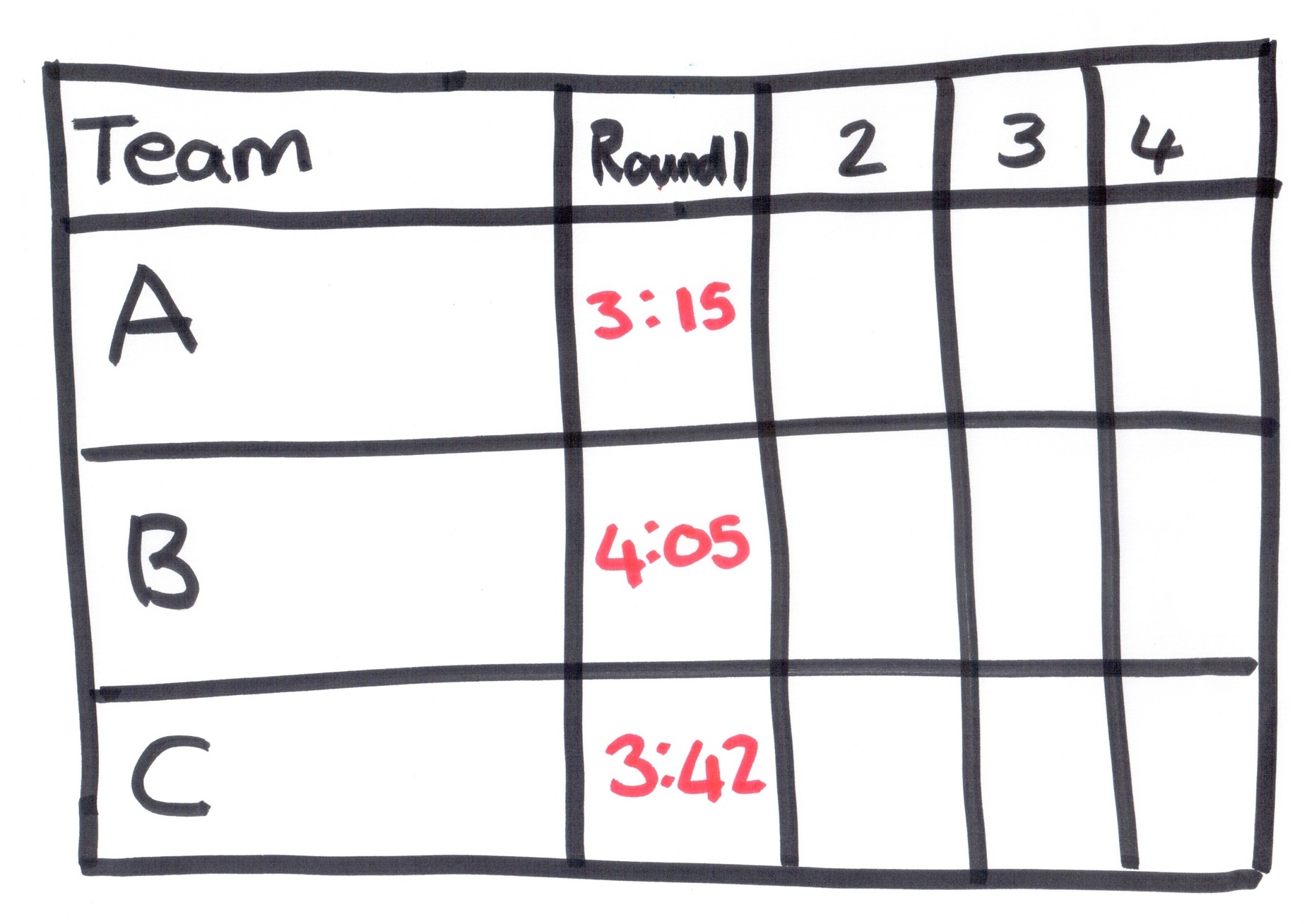
Round 2
Ask everyone to breakdown their towers for round two. Again give the testers four numbers for the ‘bugs’. This time tell them that they can test the tower after the builders have placed nine blocks. They still can’t show the team the bug numbers, but after the builders have placed nine blocks, they can tell them if any of the blocks are bugs. The builders can then remove them and continue to build. Once against start a timer as teams begin, and update the times on the score sheet for round two. In most cases the time should be less than the time for the first round.
Round 3
Again ask people to breakdown their towers. Hand out the bugs to the testers. Make sure you use different numbers for each round so that builders don’t start to guess what the bugs will be. It’s okay for teams to all get the same bug numbers though. This time let people know that the testers can check after each block is placed, and that block can be removed immediately if it is a bug. Again keep track of the time. It should now be significantly less that the first round.
Round 4
Let people know this is the final round. Sometime people can start to wonder how many times they need to build a tower at this point. Ask people to break down their towers, and hand out the bugs. This time tell the testers they can share the bug numbers with the builders at the beginning, and that they can use that information however they like. Most team immediately remove the four bugs and then build the tower. Double check though because occasionally team forget to put the bugs aside and end up including them in the tower even though they knew they are bugs in advance. Write up the time for the final round.
Debrief
Now debrief the game. Start by asking people what they notice with the times. In our experience the times for the last two rounds are fractions of the original time. Below is a copy of the results from one of the times we have run this game.
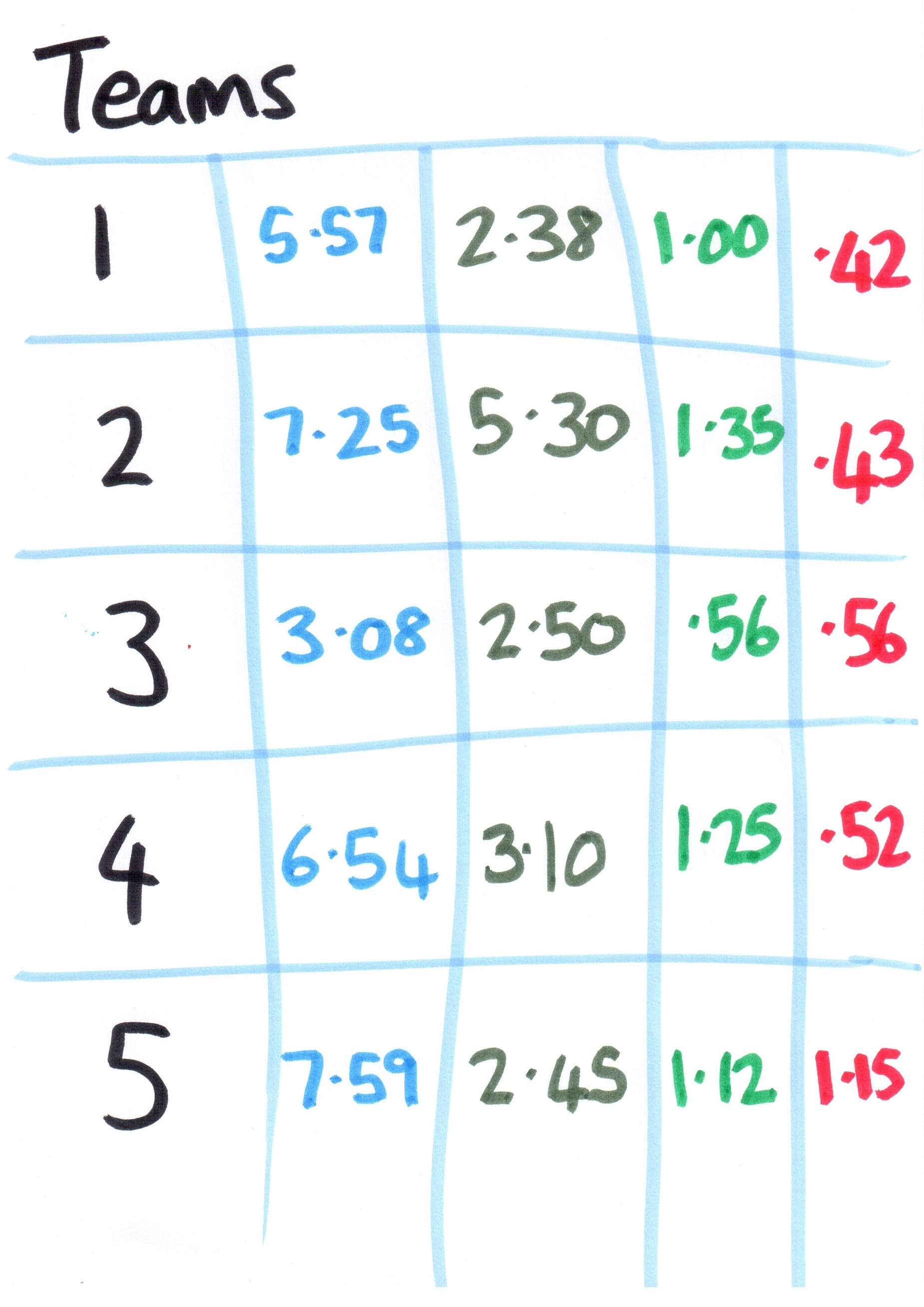
Some other questions which are useful for the debrief are:
- Which round feels like how you work today?
- Which round is how you would like to work?
- How did it feel to fix bugs in the first round?
- How did it feel to fix bugs in the other rounds?
- Do you think testing early takes more time, if so do they results change your mind?
- Do you think round four (knowing the bugs in advanced) is possible in software?
- In which rounds were testers more involved? ###How we’ve used this We use this simulation whenever we introduce agile testing as a concept to a team. It demonstrates really easily how much of a time saver it is to test early. It’s a great way to start a workshop on agile testing. We especially love the last round (our own addition to the game), which helps people think differently about testing, and introduces the agile testing principle of preventing bugs rather than finding them. ###Who shared this with us Nanda Lankalapalli
Standing Survey
| 5 - 10 | any number | Visualisation | ||
| minutes | people | Movement |
What you can learn
This is a great technique to introduce movement into a session as well as visualising information.
What you need
Decide what questions you will ask, and how you will ask people to arrange themselves in the room.
Having some open space in a room without tables and chairs is useful.
How to do this
Ask people to stand. Explain that you want them to organise themselves in the room according to some criteria (e.g. amount of Scrum experience).
Explain how to organise themselves (e.g. a single line, with no experience near the door, and most experience near the other side of the room).
Allow time for people to move around the room.
Remind people to speak to others to see where they should stand relative to each other.
Ask people to notice where other people are relative to them.
How we’ve used this
Some ideas for criteria to organise by:
- how easy you think something will be to implement (easy: one side of the room, impossible: the other )
- how well you know people in the room (close to those you know, far from those you don’t)
- people’s roles within an organisation (a quadrant with a different role in each corner of the room)
- where people are from (in the centre: close by, edges of the room: far away).
Who shared this with us
Growing Agile Books
Scrum Master Workbook - 15 Weeks of Accelerated Learning
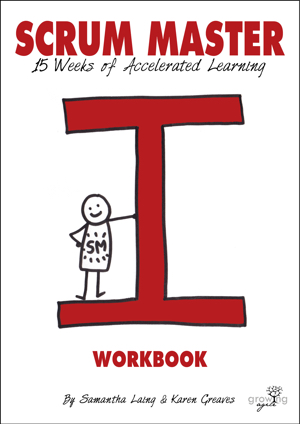
Essential for new Scrum Masters! This is a workbook you print out and fill in each week. It will guide you through a range of topics that are critical for Scrum Masters to understand. Each week will include reading, exercises and a journal page for you to reflect. We also include cutouts for your toolbox on a range of different topics.
Scrum Master Workbook is available on Leanpub.
The Growing Agile Coach’s Guide Series
This series provides a collection of training and workshop plans for a variety of agile topics. The series is aimed at agile coaches, trainers and ScrumMasters who often find themselves needing to help teams understand agile concepts. Each book in the series provides the plans, slides, workbooks and activity instructions to run a number of workshops on each topic. The interactive workshops are all created using techniques from Training from the Back of the Room, to ensure participants are engaged and remember their learnings after the workshop.
The series is available in a bundle on Leanpub, or you can purchase the books individually.
Growing Agile: A Coach’s Guide to Training Scrum
We have been training teams in Scrum for about three years. During this time we have spent many hours preparing training plans and creating workbooks, flipcharts and slides. This book will help you plan and deliver interactive, fun Scrum training for anything from a short workshop on a particular topic to a full two-day course.
Growing Agile: A Coach’s Guide to Training Scrum is available on Leanpub.
A Coach’s Guide to Agile Requirements
Our requirement workshops are aimed at different stakeholders ranging from business, to Product Owners and teams. This book is a collection of some of those workshop and can be used to help improve the way you think about and communicate agile requirements.
Growing Agile: A Coach’s Guide to Agile Requirements is available on Leanpub.
Growing Agile: A Coach’s Guide to Mastering Backlogs
Often Product Owners can’t see the forest for the trees and there are so many items in their backlog and not enough hours in the day to groom it. We run short workshops where we work with the Product Owner’s actual backlog. The workshop is a working session, and an hour later the Product Owners emerge with an improved backlog.
Growing Agile: A Coach’s Guide to Mastering Backlogs is available on Leanpub.
Growing Agile: A Coach’s Guide to Release Planning
We often hear people say “We’re agile, we don’t need a plan”! or even worse “We can’t plan”. This is just not true. We run Release Planning workshops with many organisations. This book is a collection of our workshops that will help you run similar workshops to create agile release plans. We include teaching points on a range of techniques like Story Mapping and release burnups to help you explain to other’s how to use these methods effectively.
Growing Agile: A Coach’s Guide to Release Planning is available on Leanpub.
A Coach’s Guide to Agile Testing
If a team believes they are agile, but nothing has changed about the way they test, then there is still much to learn. We teach 5 key principles that explain why agile testing is fundamentally different to traditional testing.This books includes a collection of workshops to help teams grasp these principles and adopt an agile testing mindset. It’s not just for testers. A key part of agile testing is that the whole team is involved, so we always run these workshops with everyone in the team.
Growing Agile: A Coach’s Guide to Agile Testing is available on Leanpub.
Growing Agile: A Coach’s Guide to Facilitation
It’s taken us several years to master the skill of facilitation, and it continues to amaze us how few people learn the skill, or even understand what it means. People spend much of their lives in meetings, and yet so many meetings lack facilitation. We hope the collection of tips and techniques in this book will inspire you to grow your own facilitation skills and improve the meetings in your organisation.
Growing Agile: A Coach’s Guide to Facilitation is available on Leanpub.
Other books by Growing Agile
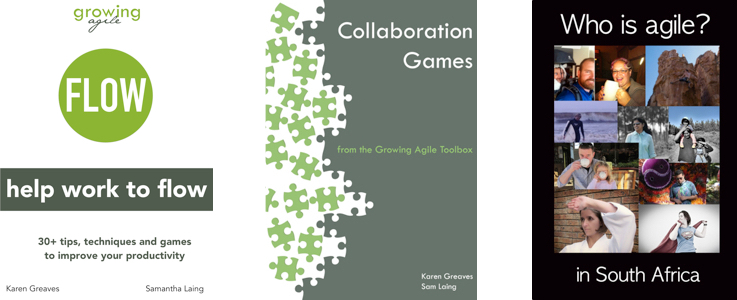
Flow
Do you have a never-ending to do list and not enough hours in the day? Imagine getting everything on your to do list done without stress or worrying. Imagine being twice as productive in half the time.
We have over 30 proven tips and techniques to help you achieve a state of flow, where time stands still and productivity soars. With these tips you will deliver value to your customers sooner in practical and simple ways. You will also be happier and less stressed.
Flow is available on Leanpub.
Collaboration Games
Add an element of fun to your meetings or workshops using these 12 short games that teach principles of collaboration.
Collaboration Games is available on Leanpub.
Who is Agile in South Africa
This book is based on the original Who Is Agile book, only this is a regional version for South Africa. It’s a collection of interviews with passionate South African agilists.
Who is Agile in South Africa is available on Leanpub.
